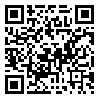Volume 35, Issue 140 (March 2023)
IJN 2023, 35(140): 560-571 |
Back to browse issues page
Download citation:
BibTeX | RIS | EndNote | Medlars | ProCite | Reference Manager | RefWorks
Send citation to:



BibTeX | RIS | EndNote | Medlars | ProCite | Reference Manager | RefWorks
Send citation to:
Nakhei A, Asadolahi Z, Hasani H, Abazari A, Abazari L, Rahimi N. Relationship Between COVID-19 Related Anxiety and Quality of Work Life in Nurses Working in Hospitals Affiliated to Rafsanjan University of Medical Sciences. IJN 2023; 35 (140) :560-571
URL: http://ijn.iums.ac.ir/article-1-3591-en.html
URL: http://ijn.iums.ac.ir/article-1-3591-en.html
1- Geriatric Care Research Center, Rafsanjan University of Medical Sciences, Rafsanjan, Iran.
2- Department of Medical Surgical Nursing, School of Nursing and Midwifery, Rafsanjan University of Medical Sciences, Rafsanjan, Iran.
3- Geriatric Care Research Center, Rafsanjan University of Medical Sciences, Rafsanjan, Iran. ,neda.rahimi90@yahoo.com
2- Department of Medical Surgical Nursing, School of Nursing and Midwifery, Rafsanjan University of Medical Sciences, Rafsanjan, Iran.
3- Geriatric Care Research Center, Rafsanjan University of Medical Sciences, Rafsanjan, Iran. ,
Abstract: (3201 Views)
Background & Aims The quality of work life (QWL) is one of the most important components in any organization. Since nurses are one of the most important human resources in hospitals, it is important to pay attention to their QWL. In this regard and due to the emergence of COVID-19 and its associated anxiety affecting the mental health and QWL of people, especially nurses, this study aims to examine the relationship between COVID-19-related anxiety and QWL of nurses in Rafsanjan, Iran.
Materials & Methods This is a correlational study with a cross-sectional design. The study population consists of all nurses working in the hospitals affiliated to Rafsanjan University of Medical Sciences during the COVID-19 pandemic in 2021. Using a census method, 300 nurses were selected, of whom 256 met the inclusion criteria. The questionnaires including 18-item Corona disease anxiety scale and Walton’s 24-item QWL scale were completed online. The collected data were analyzed in SPSS software, version 18 using t-test, one-way ANOVA, and Pearson correlation test.
Results Most of participants were female (71.9%) and married (84.4%). The mean total anxiety score was 23.97±9.84, which was at a moderate level. The mean QWL score was 79.06±12.38, which was higher than the average level. Pearson’s correlation test results the showed a negative and significant relationship between the physical anxiety score and QWL (r=-0.128, P=0.041).
Conclusion There is an negative and significant relationship between COVID-19-related anxiety and QWL of nurses in Rafsanjan city. The hospital managers and health policy makers are recommended to pay attention to mental health and QWL of nurses during pandemics and adopt appropriate strategies to improve them.
Materials & Methods This is a correlational study with a cross-sectional design. The study population consists of all nurses working in the hospitals affiliated to Rafsanjan University of Medical Sciences during the COVID-19 pandemic in 2021. Using a census method, 300 nurses were selected, of whom 256 met the inclusion criteria. The questionnaires including 18-item Corona disease anxiety scale and Walton’s 24-item QWL scale were completed online. The collected data were analyzed in SPSS software, version 18 using t-test, one-way ANOVA, and Pearson correlation test.
Results Most of participants were female (71.9%) and married (84.4%). The mean total anxiety score was 23.97±9.84, which was at a moderate level. The mean QWL score was 79.06±12.38, which was higher than the average level. Pearson’s correlation test results the showed a negative and significant relationship between the physical anxiety score and QWL (r=-0.128, P=0.041).
Conclusion There is an negative and significant relationship between COVID-19-related anxiety and QWL of nurses in Rafsanjan city. The hospital managers and health policy makers are recommended to pay attention to mental health and QWL of nurses during pandemics and adopt appropriate strategies to improve them.
Type of Study: Research |
Subject:
nursing
Received: 2022/07/6 | Accepted: 2023/02/20 | Published: 2023/03/1
Received: 2022/07/6 | Accepted: 2023/02/20 | Published: 2023/03/1
Send email to the article author
| Rights and permissions | |
 |
This work is licensed under a Creative Commons Attribution-NonCommercial 4.0 International License. |







